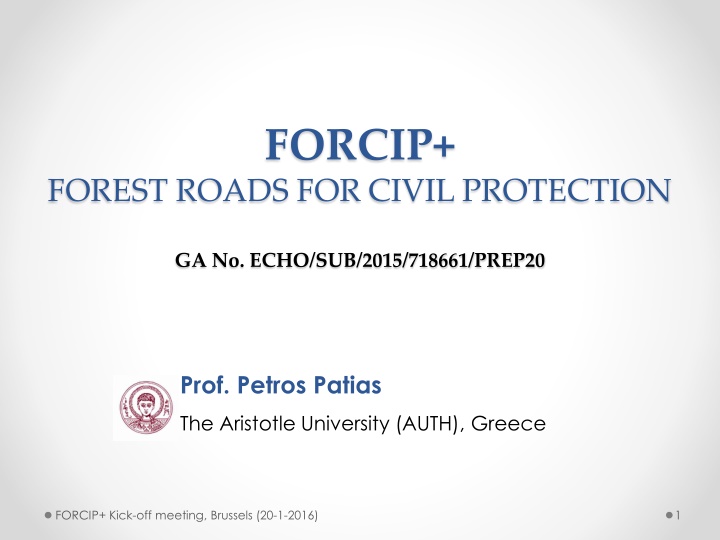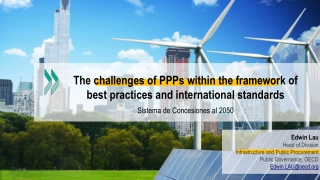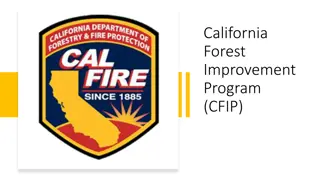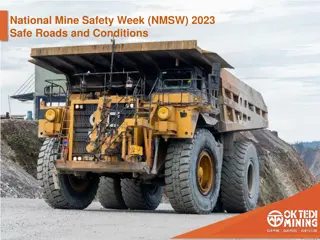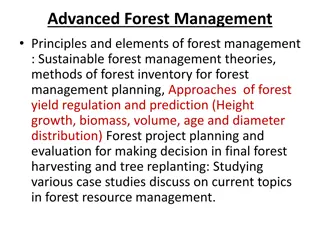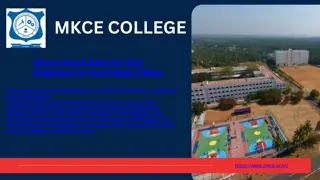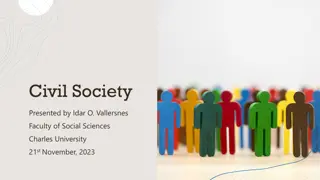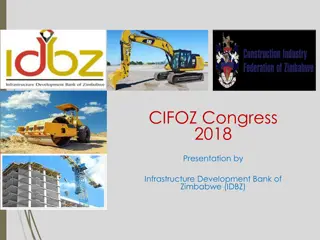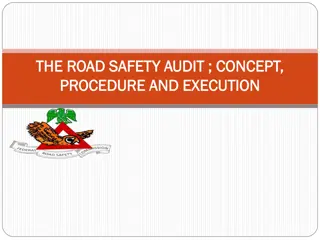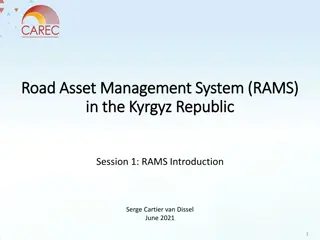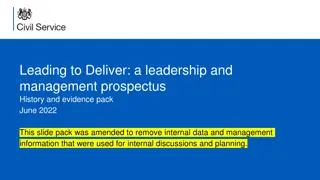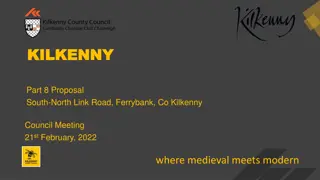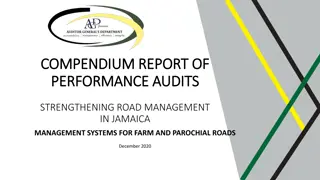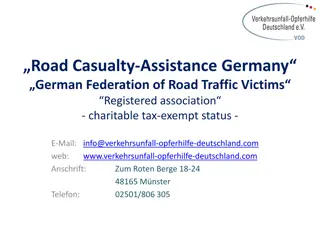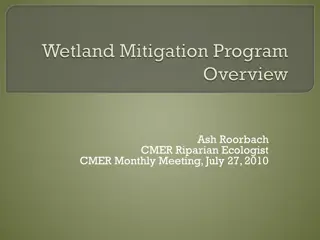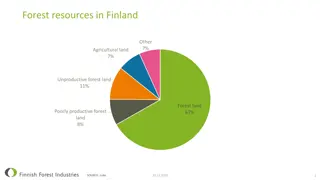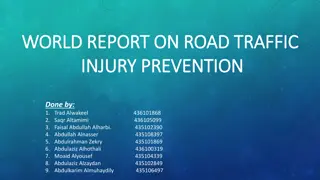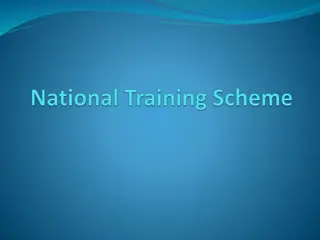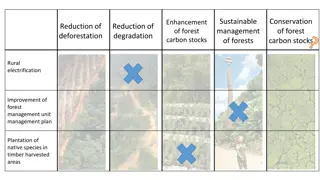Enhancing Forest Road Infrastructure for Civil Protection
This project, FORCIP+, aims to improve the rural road network for civil protection during emergencies, particularly forest fires. By utilizing transnational cooperation and ICT applications, the project seeks to enhance the efficiency and safety of forest road usage. Through the development of inventories, establishment of a standardized model, and equipping fire-fighting vehicles with GNSS receivers, the project aims to streamline response times and resource planning. Various partners bring expertise in forestry, geomatics, and environmental monitoring to this collaborative effort.
Download Presentation

Please find below an Image/Link to download the presentation.
The content on the website is provided AS IS for your information and personal use only. It may not be sold, licensed, or shared on other websites without obtaining consent from the author.If you encounter any issues during the download, it is possible that the publisher has removed the file from their server.
You are allowed to download the files provided on this website for personal or commercial use, subject to the condition that they are used lawfully. All files are the property of their respective owners.
The content on the website is provided AS IS for your information and personal use only. It may not be sold, licensed, or shared on other websites without obtaining consent from the author.
E N D
Presentation Transcript
FORCIP+ FOREST ROADS FOR CIVIL PROTECTION GA No. ECHO/SUB/2015/718661/PREP20 Prof. Petros Patias The Aristotle University (AUTH), Greece FORCIP+ Kick-off meeting, Brussels (20-1-2016) 1
Contents 1. 2. 3. 4. 5. 6. 7. 8. 9. Project info sheet Coordinator and partners Motivation Objectives Expected results Deliverables and deadlines Tentative dates and places for Major Events Budget Sustainability - Final Beneficiaries Sustainability - Continuation FORCIP+ Kick-off meeting, Brussels (20-1-2016) 2
1. Project Info sheet Activity: Preparedness Duration: 18 months Starting date: 15-1-2016 EC contribution: 400.231 Financing rate: 75 % FORCIP+ Kick-off meeting, Brussels (20-1-2016) 3
2. Coordinator and partners Coordinator: The Aristotle University (AUTH), Greece, www.auth.gr wide experience in Photogrammetry, Remote Sensing and GIS focused in Environmental Monitoring. Partners: BE1 - Office National des For ts France, www.onf.fr experience in design and implementation of the majority of the forest protection systems, ie. risk prevention plans, trails, firebreaks, clearing or undergrowth and water supply points. BE2 - Universit degli Studi di Firenze - Dipartimento di Gestione delle risorse Agrarie, Alimentari e Forestali Italy, www.gesaaf.unifi.it wide experience in geomatics, multifunctional forest road planning, silvicultural management of forest fuel, efficiency and effectiveness, health and safety in forest firefighting, as well as in applications of EO and GIS BE3 - Slovenian Forestry Institute Slovenia, www.gozdis.si experience in all aspects of sustainable development and in increasing awareness of the importance of forest conservation. BE4 - Centro de Servicios y Promoci n Forestal y de su Industria de Castilla y Le n Spain, www.cesefor.com experience in the regional Spatial Data Infrastructure (INSPIRE directive) and in communication and dissemination activities. FORCIP+ Kick-off meeting, Brussels (20-1-2016) 4
3. Motivation - Objectives Forest road network is the main means of access to the forest, for civil protection. This secondary network is not subject to approval and classification as with normal roads, so its design and construction features are highly variable. In many cases are only accessible for specific vehicles. This makes it an intricate network of highly variable characteristics by which vehicles must travel (in case of emergency) in only some areas. Other areas are generally inaccessible. The project aims at improving the use of the rural road network in case of emergency, especially forest fires. Through transnational cooperation a wide range of inventories of existing road infrastructure will be accessible, different requirements will be met and a homogeneous model will be established. ICT applications will be developed to improve the efficiency of use and propose improvements on the maintenance Forest fire fighting vehicles will be equipped with GNSS receivers in order to improve time response and increase fuel savings. Fire specialists will be able to use network analysis for resources planning, locating most suitable places for ground means waiting areas or identifying forest surfaces where takes longer to access. Other actors involved in emergencies will be able to use web management applications and public information. FORCIP+ Kick-off meeting, Brussels (20-1-2016) 5
4. Expected results Model characterization data of the rural road network that meets the requirements for use by public emergencies, especially those related to firefighting. Actual field inventory of a pilot territory in the regions involved and its inclusion in a GIS. GIS analysis of the obtained data and examples of improving the efficiency of emergency responses though network analyst tools. Guide of good practices on construction and maintenance of rural road infrastructure. Guide of project implementation in order to make it exportable to different areas. ICT applications: GNSS/GPS system, ground means management app, data update system. Project website including a cartographic viewer with OGC services for data interoperability: public use information dissemination and road alerts system. FORCIP+ Kick-off meeting, Brussels (20-1-2016) 6
5. Deliverables and deadlines/1 Project Acronym FORCIP+ Task ID Date Date Start End TaskTitle Actions Deliverables Kick-off Meeting report for all the partners Partnership agreement Quality Management and Risk Assessment Procedures - including criteria to be followed in evaluating and possibly re- directing the project development Progress Reports, including: Project Plan, Action list and Milestone Payment plan, cost reporting, travels. Minutes of Meetings Minutes of scientific project meetings Yearly assessment report Financial report Final project report Data model schema, data model dictionary Procedures and requirements (software and equipment) report GIS database form pilots area inventories Workshop and meeting Report and publication Report and publication Report and publication Workshop and meeting ICT application code and implementation ICT application code and implementation ICT application code and implementation Workshop and meeting Website description Publication of project results Brochure production Report on dissemination results 1. 1 Kick-off Meeting in Brussels for a coordination and effective management of the project and consortium 2. Ensure the administrative and financial implementation of the Contract 3. Ensure the overall scientific and technical coordination of project activities 4. Achievement of overall technical and scientific project objectives M0 M18 A Project management 1. Data model analysis and design 2. Inventory requirements 3. Data collection 4. End task meeting Data model definition and information collection M1 M15 B 1. Building and maintenance 2. Network analyst and firefighting resources planning 3. FORCIP implementation 4. End task meeting Good knowledge sharing practises and M3 M15 C 1. GNSS/GPS System 2. Data update application 3. Public information system 4. End task meeting M5 M17 D ITC applications 1. Project website and edition of good practises 2. Dissemination activities 3. Final conference Communication dissemination and E M0 M18 FORCIP+ Kick-off meeting, Brussels (20-1-2016) 7
5. Deliverables and deadlines/2 A Scientific and technical Coordination & Project Management D1.1 Kick-off Meeting report for all the partners D1.2 Opening project Meeting minute - Partnership agreement Quality Management and Risk Assessment Procedures - including criteria to be followed in evaluating and possibly re-directing the project development D1.3 Progress Reports, including: Project Plan, Action list and Milestone Payment plan, cost reporting, travels Minutes of Meetings Minutes of scientific project meetings Yearly assessment report Financial report Final project report Data model definition and information collection Report of the study about different methodologies, pros and cons Analysis of fire forest emergencies requirements Data model schema report Report of the methodology chosen. Ground for and objectives of the proposal A cartographic base. Report of sources used Selection of the solution. Report of device, software and architecture decision Spatial Database with inventoried rural roads End Task B meeting in Florence Good practices and knowledge sharing Good practices report. Building and maintenance Good practices report. Access time analysis and fire resources planning Good practises report. Forcip+ implementation Action C meeting and full report Communication and dissemination Rules (GNSS/GPS impedance attributes) report Complete cartography (each area involved) Satellite Navigation System Procedures GIS Update System report Public information system Action D meeting and full report Communication and dissemination 1 Project website 1 Project brochure in English, printed in 2500 copies 1 complete mailing list; 1 project Facebook profile D5.4 N1-N3 3 Newsletters D5.5 1 Final conference D5.6 1 Poster R1-R6 Y1-Y2 F1-F2 FR1-FR3 FPR B D2.1 D2.2 D2.3 D2.4 D2.5 D2.6 D2.7 D2.8 C D3.1 D3.2 D3.3 D3.4 D D4.1 D4.2 D4.3 D4.4 D4.5 D4.6 E D5.1 D5.2 D5.3 FORCIP+ Kick-off meeting, Brussels (20-1-2016) 8
5. Deliverables and deadlines/3 Year 1 Year 2 Leaders -16 1 -16 -16 -16 2 3 -16 5 -16 6 -16 7 -16 8 -16 9 -16 10 -16 11 -16 12 -17 13 -17 14 -17 15 -17 16 -17 17 -17 18 4 T1 A1 A2 A3 A4 B Scientific and technical Coordination & Project Management Kick off Meeting administrative and financial implementation of the Contract scientific and technical coordination of project activities achievement of overall technical and scientific objectives of the project Data model definition and information collection AUTH AUTH AUTH AUTH AUTH CESEFOR D1.1 R1 R2 FR1 R3 R4 R5 R6/ FPR Y2 /FR3 Y1 /FR2 D1.2 D1.3 D2.1 D2.2 D2.3 D2.4 B1 Data model analysis and design CESEFOR D2.5 D2.6 B2 Inventory requirements AUTH B3 B4 C C1 C2 C3 C4 D Data collection end task meeting Good practises and knowledge sharing Good practises: building and maintenance Network analyst and firefighting resources planning FORCIP+ implementation end task meeting ICT applications D2.7 D2.8 CESEFOR UNIFI SFI UNIFI SFI SFI SFI ONF D3.1 D3.2 D3.3 D3.4 D4.1 D4.3 D1 Satellite Navigation System D4.2 ONF D2 D3 D4 E E1 E2 E3 GIS Update System Public information system end task meeting Communication and dissemination Project website and edition of good practices Dissemination activities Final conference Mt0: Brussels, 20-1-2016 Mt1: Thessaloniki (M2) Mt2: Florence (M12) Mt3: Aix en Provence (M16) Mt4: Lubljana (M17) Mt5: Valladolid (M18) D4.4 CESEFOR AUTH ONF CESEFOR CESEFOR CESEFOR CESEFOR AUTH AUTH UNIFI ONF SFI CESEFOR D4.5 D4.6 D5.1 N3 D5.5 D5.3 D5.2 N1 D5.6 N2 20/1/16 Meetings FORCIP+ Kick-off meeting, Brussels (20-1-2016) 9
6. Tentative dates and places for Major Events Mt0: Brussels, 20-1-2016 Mt1: Thessaloniki (M2) Meetings Mt2: Florence (M12) Mt3: Aix en Provence (M16) Mt4: Ljubljana (M17) Mt5: Valladolid (M18) FORCIP+ Kick-off meeting, Brussels (20-1-2016) 10
7. Budget % of eligible costs 75.00% Part A: Eligible cost categories Rate % Part B: Financing Plan 400,231 Personnel 339,866Requested EC contribution 31,150Contribution of the Coordinator 6,720Contribution of the Beneficiary (ies) Travel and subsistence 32,465 6.08% Equipment 95,945 17.98% Sub-contracting / External assistance Other direct costs Indirect costs / overheads 89,000Other sources of funding 5,000 0.94% 36,700Expected direct revenues 30,206 0 0.00% 6.00% TOTAL ELIGIBLE COSTS 533,642TOTAL 533,641 FORCIP+ Kick-off meeting, Brussels (20-1-2016) 11
8. Sustainability - Final Beneficiaries Spain 1. Junta de Castilla y Le n: holds the competency for forest firefighting, both prevention and fight. Their technicians will incorporate this project s data for the daily use when performing forest fire prevention tasks and suppression decisions in real time. 2. Civil Protection service (Castilla y Le n regional Section) 112 service: improve cartographic data. 3. Seprona Guardia Civil. Spanish rural police (Environment Protection Service): improve cartographic data. Greece The Forest Department of Kozani, Region of Western Macedonia. France All the local partners involved in operational systems of monitoring or firefighting network : 1. Foresters from: Province -Conseil G n ral-, national authorities -Direction D partementale des Territoires- 2. Firefighters (from Service D partemental d'Incendie et de Secours) to improve security (reliable database of roads + on-time knowledge of position by headquarters and operators) and efficiency (optimization of access to the fires); Italy 1. Tuscany region (Regional Government, Forest Fires prevention Department) 2. CVT (Coordinamento volontari toscani): Consortium of associations of volunteers dealing with civil protection (ANPAS, CROCE ROSSA, VAB) 3. Corpo Forestale dello Stato (National Forestry Service) Slovenia 1. Slovenian Forestry Service: it looks forward to a practical LIDAR-based method of skidding trail inventory (letter of support attached). 2. Administration for civil protection and disaster relief: they are interested in optimizing the disaster management system and in general and forest fire suppression in particular. FORCIP+ Kick-off meeting, Brussels (20-1-2016) 12
9. Sustainability - Continuation Open source: ICT applications and software required in the project will be open source wherever possible. This software will be free to use, distribute and modify. Data update system: the project provides a tool to maintain the cartography updated (Satellite imagery, GIS systems); this tool will keep the inventory up-to- date and connected to other applications ie. the GNSS system. Involvement of end users: organizations with (a) competences and responsibility to maintain the inventory - costs of maintenance are negligible once the inventory and applications will be developed within this project s framework. (b) Applications and GIS structure with open source software allows end users to develop and maintain tools and information. Expandable GIS system: with additional relevant information (eg. biomass, forest management, etc) Final Report: a Roadmap to other European areas; Dissemination of experience and good practices FORCIP+ Kick-off meeting, Brussels (20-1-2016) 13
